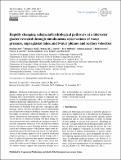Rapidly changing subglacial hydrological pathways at a tidewater glacier revealed through simultaneous observations of water pressure, supraglacial lakes, meltwater plumes and surface velocities
Abstract
Subglacial hydrological processes at tidewater glaciers remain poorly understood due to the difficulty in obtaining direct measurements and lack of empirical verification for modelling approaches. Here, we investigate the subglacial hydrology of Kronebreen, a fast-flowing tidewater glacier in Svalbard during the 2014 melt season. We combine observations of borehole water pressure, supraglacial lake drainage, surface velocities and plume activity with modelled run-off and water routing to develop a conceptual model that thoroughly encapsulates subglacial drainage at a tidewater glacier. Simultaneous measurements suggest that an early-season episode of subglacial flushing took place during our observation period, and a stable efficient drainage system effectively transported subglacial water through the northern region of the glacier tongue. Drainage pathways through the central and southern regions of the glacier tongue were disrupted throughout the following melt season. Periodic plume activity at the terminus appears to be a signal for modulated subglacial pulsing, i.e. an internally driven storage and release of subglacial meltwater that operates independently of marine influences. This storage is a key control on ice flow in the 2014 melt season. Evidence from this work and previous studies strongly suggests that long-term changes in ice flow at Kronebreen are controlled by the location of efficient/inefficient drainage and the position of regions where water is stored and released.
Citation
How , P , Benn , D I , Hulton , N R J , Hubbard , B , Luckman , A , Sevestre , H , van Pelt , W J J , Lindbäck , K , Kohler , J & Boot , W 2017 , ' Rapidly changing subglacial hydrological pathways at a tidewater glacier revealed through simultaneous observations of water pressure, supraglacial lakes, meltwater plumes and surface velocities ' , The Cryosphere , vol. 11 , no. 6 , pp. 2691-2710 . https://doi.org/10.5194/tc-11-2691-2017
Publication
The Cryosphere
Status
Peer reviewed
ISSN
1994-0416Type
Journal article
Description
This work was funded by the Conoco Phillips-Lundin Northern Area Program through the CRIOS project (Calving Rates and Impact On Sea level, http://www.researchinsvalbard.no/project/7037). Penelope How is supported by a NERC PhD studentship.Collections
Items in the St Andrews Research Repository are protected by copyright, with all rights reserved, unless otherwise indicated.

